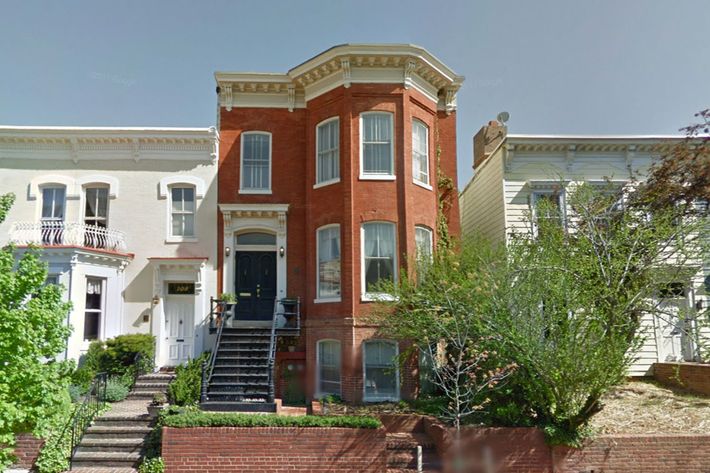
When Steve Bannon was the chief strategist and senior counselor to President Donald Trump, he spent his days and often long into his nights in an office on the first floor of the West Wing, separated from the Oval Office only by his neighbor Jared Kushner and the presidential study.
He called the space his war room, and, as if to prove the point, he removed the comfortable fixtures — the couch and bookshelves — left by its previous tenant, John Podesta, and installed a large whiteboard on which he wrote the promises Trump had made during the campaign: “End ‘Catch and Release’”; “Suspend the Syrian Refugee Program”; and so on. Bannon cast himself as a warrior for far-right populism — someone so committed to his cause that he rarely glimpsed daylight. “This is like being in the Navy, this is like a duty,” he told me then. “I don’t enjoy this every day. This is not living; this is a kind of existence.”
The last time I saw him before he was fired in August, West Wing construction had forced him across the driveway into a temporary office in the Eisenhower Executive Office Building. His central whiteboard had been relocated to basement storage, and a smaller version had been wheeled in and positioned by the desk. Anywhere Bannon is existing, it seems, becomes a kind of pop-up war room.
Since leaving the White House and its adjacent properties altogether, he’s moved his operation back into a war townhouse he calls the Breitbart Embassy. Breitbart News, where he’s the executive chairman, is headquartered in the basement; upstairs, he hosts glitzy parties and plans his hostile takeover of the GOP. And, depending on which sources you believe, the Breitbart Embassy is also where he happens to live.
Like so many things involving Steve Bannon, the banal subject of his permanent residence has long been a mystery. This is by design — whether to protect himself or add to his own legend, who knows. According to public records, over the last several years he’s had addresses in California, New York, and Florida, where he registered to vote but never so much as obtained a driver’s license.
During his time in the White House, rumors circulated in D.C. about the Breitbart Embassy; he was thought by many in the White House press corps to be living there despite having claimed to put a barrier between himself and the website he ran that served, during the campaign and thereafter, as Trump’s very own Russia Today. During the campaign and into the current administration, there was little meaningful difference between Breitbart’s coverage of Trump and Trump’s own press releases. Under Bannon, Breitbart also incubated and amplified voices that played at the edges of right-wing extremism. In 2016, Bannon referred to it as “the platform of the alt-right,” but attempted to move closer to the middle — by hiring staff with traditional journalism backgrounds — once the alt-right became synonymous with neo-Nazism.
Even now, with ethical constraints in the rearview mirror, Bannon is unwilling to admit that he calls the Breitbart Embassy home. A source with knowledge of his real-estate holdings told me he lives in Northern Virginia and stays at the Embassy when his schedule demands it, but provided no further details or proof. Another source close to Bannon told me that wasn’t true, and for what it’s worth, the general consensus here in D.C. is the same. “Steve lives on the top two floors,” this source explained, “so Steve will do his meetings at the second-floor dining-room table.”
The $2.35 million, three-story structure on A Street Northeast near Capitol Hill is owned by a former member of the Egyptian parliament named Moustafa El-Gindy.

The first source close to Bannon, who claimed he doesn’t really live there, also claimed Bannon rents the place and is now negotiating to buy it.
El-Gindy didn’t respond to a request for comment, though he told the Egyptian press in 2016, “I am just a landlord.” But as Rosie Gray reported at the time, Breitbart “has repeatedly written about El-Gindy without disclosing the relationship, often referring to him as a ‘senior Egyptian statesman.’” Further, a former Breitbart employee told Gray, “El-Gindy does stay in the house sometimes.”
If Bannon doesn’t actually live there, he has a weird way of showing it.
He keeps pages of instructions for his post–White House diet plastered on the fridge and a picture of his daughter on the mantel (in it, she holds a machine gun and sits on a throne that Josh Green reported may have once belonged to Saddam Hussein). As a party raged inside last month, his security could be seen moving out his luggage and loading it into a car bound for the airport — and who keeps luggage in their office?
Whatever the case, in the deeply weird environs of Washington in the Trump era, the Breitbart Embassy, as the command-and-control center of the far-right insurgency against the conservative political Establishment, has taken on a sense of ominous gravity — in spite of being more than a little ridiculous. If, like in Ghostbusters, there were a vortex above one building in this troubled city, it could be this one rather than the White House or the Capitol.
Funded by the billionaire Republican donor Robert Mercer and his daughter Rebekah (despite Robert’s recent announcement that he plans to distance himself from Breitbart, he’s not expected to distance himself financially or otherwise from Bannon’s upstairs activities), Bannon has promised to challenge every Republican in Congress except for Ted Cruz, particularly those in open opposition to the president or tethered to the leadership, Mitch McConnell and Paul Ryan.
Built in 1890, the Embassy has a vibe that is less Office Space or evil-genius lair and more what it might look like if a wicked witch turned a Civil War reenactor into a house. Gold curtains adorn the intricately muraled walls, and crystal chandeliers float overhead. The carpet is a serene shade of blue, dotted with white stars. There’s a lot of gleaming, yellow brocade.
Past the dining room, a pile of lanyards bearing Bannon’s press credentials hangs on a doorknob. Guards that sources close to Bannon claimed were former Marines and Navy SEALs stand at the doors at all hours, letting in a parade of candidates who want Bannon’s approval and keeping out nutjobs and other unwelcome visitors.
“This idea that it’s just, like, this band of pirates is not totally accurate,” one source close to Bannon said of the Embassy’s inner workings. This person stressed that although there are “an enormous amount of people that come and go and leave from the Embassy,” the chaos is structured.
“People spin in and out of the room,” another such source added.
Inside, Bannon is aided by a small team of loyalists: Andrew Surabian, an adviser who followed him in and then out of the White House and who the source likened to a “director of strategy”; Alexandra Preate, Bannon’s spokeswoman and Girl Friday, described as the “director of operations”; and Matthew Boyle, the Washington political editor of Breitbart who has become, as the website staffer closest to Bannon, something of a D.C. media celebrity.
Candidates and other potential collaborators stream into the dining area for meetings scheduled as late as 10 p.m. Bannon is almost always running behind, but his guests are content to wait. If a meeting goes well, as it did with Michael Grimm, a Republican primary candidate in Staten Island, he’ll pose for a photo, a token for the politician, and even more valuable, a sure way to generate interest from the media and potential supporters.
“At the White House, I had influence,” Bannon said after being fired as the president’s chief strategist. “At Breitbart, I had power.” Through some old-fashioned PR guru moves, the perception of that power has only inflated since his return.
The lines between Breitbart’s publishing and political factions were always barely existent, but they’re even less clear now. By working for Breitbart, Matthew Boyle is also a political operative, and as the first year of Trump’s term slumps to a close, the outsiders of the Embassy are feeling more convinced of the nobility of their cause than ever.
In the special election in Alabama, Breitbart has favorably reported on Roy Moore, the candidate endorsed by Bannon in the Republican primary over Luther Strange, who was supported by both McConnell and the president. Over the past several days, as Moore has faced allegations that he had sexual encounters with underage girls in the late 1970s and early ’80s, Breitbart has responded by casting doubt on the reporting and dismissing opposition to Moore as an attempt by the mainstream media and the Establishment to take out a populist conservative.
In its recent Moore coverage, Breitbart has shown a willingness to go to the grossest of lengths to fight off McConnell — picking populist purity at any cost, even if it means siding with an alleged child molester. Bannon’s calculus, according to the source close to Breitbart, is that after Election Day, hardly anyone will remember how the organization covered the Moore story, but he’ll have one more victory to brag about. (While a report appeared on Tuesday suggesting that privately Bannon was considering dropping his support for Moore, none of the sources close to Breitbart or Bannon I spoke with in the hours before and after the story appeared expressed anything similar.)
That source close to Breitbart, talking about the website’s coverage of Moore, told me: “This is probably the most resilient bunch of people in the news-media world. The whole fucking honey-badger thing is not just a shtick, it’s the truth.” (The Breitbart motto is “honey badger don’t give a shit,” after the meme.) “And here’s the thing about the Moore stuff,” the source said. “As much as I’m inclined never to challenge a claim like this —why now?”
The source added, “I don’t think it’s the hill that Breitbart dies on. At worst, it’s an uncomfortable few days.”
Breitbart staffers have an editorial conference call each day, and Bannon often takes part — when he was fired from the White House, he joined the call that evening, officially announcing his return. But Bannon doesn’t carefully manage the site’s coverage during a major scandal or crisis with implications for one of his candidates — rather he believes that his employees already abide by a common worldview, and know what to do.
The night of the party last month — thrown in honor of Laura Ingraham’s new book Billionaire at the Barricades — Boyle stood at the top of the stairs leading into the house, peering out before a procession of friends, colleagues, sympathizers, and, uncomfortably, members of “the opposition party” (a.k.a the mainstream press), who snaked along the brick path and onto the sidewalk, waiting to check in with security. He wore a distinct look of satisfaction as he craned his neck to get a better view of the scene.
In the living room, the clanking of glasses and nice-to-see-yous quieted down as Bannon spoke. “One thing I want to talk about: this historic house we’re in — Andrew Breitbart, this is where we actually started the news site you see today,” he said. “The old Breitbart blog is from the West Coast, that’s where our headquarters and home is, but the Embassy is where we first started to build it. It’s a very historic house for the populist, nationalist movement.”
Under his management, the Breitbart Embassy also became one of D.C.’s best party houses; an annual event during the Conservative Political Action Conference was attended by everyone from Louie Gohmert and the Duck Dynasty guy to ironic liberal reporters and feminists. Until morning, guests were drinking and smoking cigars before the live band in the living room or partaking in the more frat-like scene on the back patio (the Daily Caller once reported the party had “an orgy vibe”).
Although the newsroom is technically downstairs, five sources close to Bannon or who currently or once worked for Breitbart told me that hardly anyone shows up, preferring to work remotely.
With a kitchen, bedroom, dining, and living area with gray walls and yet another chandelier, the basement looks more like an apartment than a news operation.
One former Breitbart employee said that unless another staffer passed out after partying the night before, sometimes the only sign of life was the caretaker who worked upstairs. “It was just me by myself all day,” the former employee said. “No one went in unless Bannon called for an in-person meeting or if we had a party.”
Addressing his party guests, Bannon pointed out a table where he said Jeff Sessions sat years ago with Stephen Miller to discuss “trade” and “illegal immigration,” and how to make those topics wedge issues in an upcoming election. He recalled the time Laura Ingraham brought over a young woman named Julia Hahn who told him about a candidate named David Brat who was running to defeat the Establishment in Virginia. Hahn is now a special assistant and deputy strategist to the president, while Brat serves in Congress, having unseated the House Majority Leader Eric Cantor in a historic upset that the national media (with the exception of Breitbart) missed.
Bannon looked considerably less dead than he had during his final days with the president. He’d lost in weight the equivalent of a healthy 6-year-old through some combination of juicing and avoiding simple carbohydrates.
“Did you see his fucking diet on the refrigerator?” a member of the media who attended the party asked me. On the fridge were pages of paper detailing his dietary guidelines, including a list of acceptable foods and instructions for how and when to consume them. “It was like, ‘Snacks are bad but if you must snack here are some approved snacks: hummus with this.’ Fuck, I should’ve taken a picture,” the member of the media said.
Surrounding Bannon were other members of his staff and his movement, naturally, but also Establishment conservatives, people with ties to Paul Ryan or who had worked for Mitt Romney or Scott Brown. Late in the evening, Sean Spicer showed up. “All of these, like, Romney people eating beef tenderloin and ham croquettes,” a member of the media remarked, in shock. “How thirsty are you gonna look waiting to talk to Steve Bannon?” The room wasn’t smoke-filled, but guests quite literally slapped Bannon’s back and whispered into his ear. I even saw one guy I’d met in Iowa when he was working for Hillary Clinton; he walked around with his eyes bulging, like he’d sleepwalked his way into the party and had just been jolted awake.
But even more telling was the presence of mainstream journalists — from CNN, the Washington Post, Bloomberg, the New York Times, Politico, GQ, Axios, The Atlantic, and New York — some of whom were there under the pretense that the party was off the record. Schmoozing with sources or observing up close the debauchery of subjects is sometimes part of the game, of course, but there was a palpable unease in the room — who exactly was using who here? The Breitbart Embassy of yore had been a fringe enclave; but in 2017, it’s a venue for Bannon to showcase his unusual, if overstated, political power.
An elderly woman barreled through the crowd, elbows out, just to get near Bannon for a photo. Observing the press observing this scene, he beamed as if radioactive.
I walked through the kitchen, where Stephen Miller was hunched over the counter, shoving cookies into his mouth. A few minutes earlier, to the crowd in the living room, Bannon had introduced Miller, a senior policy adviser to the president, as “the last man behind enemy lines.”
“It’s quintessential Bannon,” said a journalist who attended the party. “He wants to be seen as this populist, flame-throwing, take-on-the-whole-Establishment — and yet he has a Dean & Deluca party and clearly covets everyone being there, standing under chandeliers and taking selfies, and his private security carrying his bags out to the private plane to California.”






























